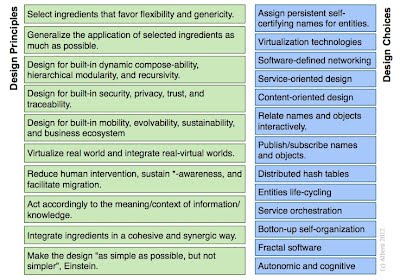NovaGenesis is a set of processes that runs over a computing operating system aimed at doing information exchanging and processing based on legible and Self-Certified Names (SCNs). NovaGenesis aims at creating a bottom-up self-orchestration environment where simple processes can give rise to complex systems. It uses SCN-based bindings to create a graph that represents all entities relations.Entities publish/subscribe SCN-based bindings that are stored at Distributed Hash Tables (DHTs). Search and discovery are active ingredients of the architecture.
Overview
NovaGenesis (NG) is a "colony" of collaborating, distributed, active, digital entities aimed to orchestrate complex functionalities based on the subscription of published passive digital information. The NG processes run over a computing operating system aimed at doing information exchanging and processing based on Self-Certifying Names (SCNs). NG employs a bottom-up self-organization paradigm to create a digital ecosystem, where simple entities maintain rich relationships based on SCNs. NG uses SCN-based bindings to create a distributed graph that aims to represent all entities relationships. Those SCN-based bindings are published/subscribed by active entities and stored at Distributed Hash Tables (DHTs).
NG cohesively integrates several conceptual ingredients present on contemporary networking research to meet our society ICT needs. The proposed architecture is based on some fundamental principles that have been carefully selected on literature and merged to provide a convergent design. Therefore, the main contribution of NG is to synergistically integrate some of the key design principles that are being considered for Future Internet in a self-similar blueprint. The most primordial principle considered was to design based on entities and objects SCNs. Therefore, NGʼs architecture merges all the remaining architectural ingredients using a SCN-based approach (in practice, it can be considered an ID-based approach).
NovaGenesis (NG) is self-similar in the sense that it uses the same common ingredients (or abstractions) at several levels. It merges information- and service-centric approaches, virtualization of substrate resources, self-organizing networking, pub/sub paradigm, search and discovery, entities social relationships, among other ingredients, in an unique, evolutionary, convergent, digital business ecosystem. Therefore, tries to go deeply on exploring the interrelations among selected ingredients to capture their essences.
Figure 1 illustrates the NovaGenesis design principles and adopted choices. Every design choice is a selected ingredient. Therefore, NG design tries to generalize their application on the remaining ingredients. For example, a selected ingredient was the virtualization technology. NG tries to explore the application of this choice to all the others ingredients. It means that every real world resource needs to be virtualized and virtualization must be explored by other ingredients, like software-defined networking, service-oriented design, content-oriented design.

NovaGenesis aims at offering mobility support at all scales and for all entities. It also wants to integrate recent efforts on information-, service-, user-, and content-centric designs. Entities life-cycling, bottom-up, semantics rich orchestration are other design choices. Autonomic and cognitive technologies are also desired to reduce human intervention and operational costs. Security, privacy, trust, and traceability are also requirements. Another point is to integrate real world resources and devices with virtual services and applications, like in the recent approaches of Internet of Things (IoT) and Real-World Internet (RWI). To design with improved levels of awareness is also a guideline. It means to apply the network-awareness, service-awareness, *-awareness, on the design choices.
Another concern is to facilitate migration to the NG architecture. Flexible design choices help to accommodate already existent technologies on NG proposal. The final aim is to create a network that self-organize towards client intentions, desires, meaning, context, etc. The objective is to accommodate evolution inside the architecture itself as well as to sustain the design as long as possible. Finally, by integrating evolvable services and content on the same architecture, NG aims at creating a rich Digital Business Ecosystem where clients and services can express their intents, goals, preferences, objectives, etc., and the network can adjust its functionalities to provide the adequate services. On the other side, the existent hardware resources are virtualized, shared, and dynamically exposed to service orchestration. NG aims at creating a “digital Savannah” where virtual entities collaborate and compete for available resource trying to better meet society desires.
(c) Antonio Alberti, 2012, Inatel.